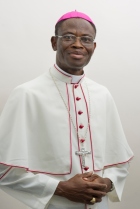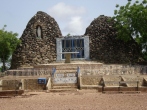About US
Catholic Diocese of Navrongo-Bolgatanga
Bishop: Most Rev. Alfred Agyenta, SSL, STD, DD
History and Population
The Diocese of Navrongo-Bolgatanga started in 1906 when the Missionaries entered Northern Ghana through Burkina Faso. They first settled in Navrogo and gradually spread throughout northern Ghana. The total land area covered by the Diocese is 31,068 square kilometres. The diocesan population is currently estimated at 1.5 million at a growth rate of 3% per annum. Forty-five percent (45%) of the population is below 14 years old. The female population is higher (52.4%) than the male (47.6%) with the sex ratio of 9:11. The population in the diocese which is predominantly rural is scattered among several small localities with some having very high population density of 260 persons per square kilometre.
Political Boundaries
The Diocese coincides with the political administrative region of the Upper Easter and part of Northern Region of Ghana and covers an area of 31,068 sq. km. The Upper East Region is made up of 12 districts namely: Kasena-Nankana, Kasena-Nankana West, Bongo, Bolgatanga, Bawku, Kawku West, Talensi, Babdam, Garu-Tempane, Builsa North, Builsa South and Binduri. Part of the Northern Region within the diocese include: West Mamprusi, East Mamprusi, Mamprugu-Moagduri and Bunkpurugu-Yunyoo districts. All these districts and municipalities fall under 14 parishes and three Rectorates as ecclesiastical demarcations.
Geographical Features
The Diocese generally falls within the Guinea Savannah zone, although some portions of its catchment area (Bawku) are within the Sudan Savannah ecology. The natural vegetation is Savannah woodland consisting of short, deciduous, widely spread fire-resistant grasses and shrubs. Human activities have reduced the vegetation to an open land with some trees of economic value retained.
The annual average rainfall which decreases from south-east to north-west varies from a minimum of 645 mm to a maximum of 1,250 mm with a mean of 1,044mm. Rainfall is limited to one season (Mid April to October) and can be very irregular, with frequent dry spells during June and July which is a critical period for crop growth. The dry season begins from mid-October to the first two weeks of April. This period is characterized by dry, dust-laden North-East Harmattan winds from the Sahara desert.
Socio-economic Features
The climate is generally suitable for the production of single wet season crops. The soils have poor water holding capacity which poses a considerable constraint to agricultural productivity. This single cropping season which depends on rainfall occurs from May to October with considerable under-employment of labour. This period is followed by a long dry season resulting in seasonal migration of the productive labour force to southern Ghana in search of greener pastures.
Poverty is very high among the diocesan populance especially the rural areas. The Upper East Region which forms most part of the Diocese is currently assessed the second poorest region of the Country. It is estimated that 80% of the population of the Region is below the poverty line, compared to the national average of 66% (Ghana Poverty Reduction Strategy II, 2005). The main economic activity of the population is agriculture with 85% being peasant farmers. A small percentage of population is involved in the handicraft industry. The proportion of females in sales work (13.3%) is twice that of males (5.8%). The proportion of males in agriculture is 71.8% compared to 61.2% females (Ghana living standards survey report, 2008).
More than 88% of the diocese’s 1.5 million people are rural dwellers depending mainly on rain fed agriculture for food and income. Income levels of the population are generally low due to the poor soils to support crop growth, erratic rainfall and other adverse agriculture practices.
Ninety percent (90%) of the housing units are made of bricks with high cost of repairs and maintenance.
Style buildings are changing as a result of improved technology. All the district capitals are connected to National Grid and Telecommunication networks.
Ecclesiastical Data
What is now the Navrongo-Bolgatanga diocese has had a history of 106 years of evangelization (1906-2012), the longest in the Tamale Ecclesiastical Province. The small detachment of the members of the Society of Missionaries of Africa (White Fathers) who arrived in 1906 pioneered the evangelization of Navrongo and its environs.
From their efforts, a new ecclesiastical territory emerged, first, in the form of an Apostolic Prefecture in 1926, and then an Apostolic Vicariate in 1934. From 1950 the territory became part of the newly created diocese of Tamale. In 1956 the Diocese of Navrongo was erected, a status the territory enjoyed until 1977 when it received the new name of Diocese of Navrongo-Bolgatanga, following the erection of the Tamale Ecclesiastical Province.
The major religions in the diocese are the African Traditional Religion, Christianity and Islam. In the Upper East part of the Diocese, the Traditional Religion remains the dominant religion (46.4) followed by Christianity (28.3%) and Islam (22.6%).
In the Northern Region part of the diocese, however, the situation is different. For instance, in the Mamprusi West/Yagiba (Walewale Parish), the dominant religion is Islam (66.7%), followed by the Traditional Religion (16.3%) and Christianity (14.4%). On the other hand, there is a balance between the three major religions in the East Mamprusi part of the diocese, i.e. Christianity, has a slight edge with (35.1%), followed closely by the Traditional Religion with (32.6%) and Islam (30.4%).
When one narrows down to Christianity, Catholics dominate (57.7%) followed closely by Pentecostal/charismatic groups (21.7%) and the protestant (12.3%). The Catholic population is served by 55 priests, 36 religious men and women, 14 full time catechists and about 220 voluntary prayer leaders.




Please revise the historical note. The diocese did not just begin from 1977. Give your readers a better history.
This is a good work done by our forefathers.we higghly appreciate their effforts.God richly bless them.
Good work done. I hope the name of parishes and priest in the diocese will be included.
God bless those who put all this together.
I attended a catholic school in a village around Temale in the 60s, we left Ghana in 1970 during president Busia’s Nigerian’s exodus. I was a little girl then. How can I locate the school since I don’t have any official record to show for it. My parents are late,no one to guide me to this information. I need someone from that area that can help me. I wish to visit the town to see the school again. Thanks.
Did the new of the Navrongo-Bolgatanga diocese as a result of the erection of the Tamale Ecclesiastical Province? This is wrong history and misinformation of the future generation. Lets tell the facts as they are.
let’s get realistic accurate in matters of building the church that christ started.In terms of the 3 religion, what is our growth rate.i undrestand we are dropping to Islam and Traditional religion even nation wide. it is wise and good to revise our core evengelical tactics and respond to questionaire of this millenium world since we cannot boast of someones’ foundation.Where is our block to help the building process.What was done is too much in the church of late meanwhile the people want what is and will be since the old is now considered outmoded.ACT,NOW! Bravo to our old fathers.
the Catholic Church in the navrongo -bolgatanga diocese have started something they cannot finish.
what has the diocese started that it cannot finish? Please be a little bit polite when giving your comments. it is not easy to dig out old stories especially from the 1900s. if you have better history please provide it and stop some of the unnecessary comments. anyway bravo to those who are proving us with this history. keep it up. However, my plea is ” please priests unite and work for the betterment of the diocese.”
SHIRIFAT, If you can provide the name of the school, it help you able to locate the school easily